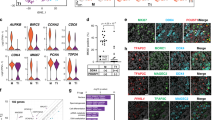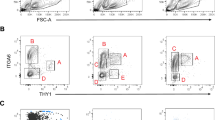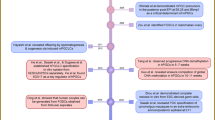Abstract
Embryonic germ cells as well as germline stem cells from neonatal mouse testis are pluripotent and have differentiation potential similar to embryonic stem cells1,2, suggesting that the germline lineage may retain the ability to generate pluripotent cells. However, until now there has been no evidence for the pluripotency and plasticity of adult spermatogonial stem cells (SSCs), which are responsible for maintaining spermatogenesis throughout life in the male3. Here we show the isolation of SSCs from adult mouse testis using genetic selection, with a success rate of 27%. These isolated SSCs respond to culture conditions and acquire embryonic stem cell properties. We name these cells multipotent adult germline stem cells (maGSCs). They are able to spontaneously differentiate into derivatives of the three embryonic germ layers in vitro and generate teratomas in immunodeficient mice. When injected into an early blastocyst, SSCs contribute to the development of various organs and show germline transmission. Thus, the capacity to form multipotent cells persists in adult mouse testis. Establishment of human maGSCs from testicular biopsies may allow individual cell-based therapy without the ethical and immunological problems associated with human embryonic stem cells. Furthermore, these cells may provide new opportunities to study genetic diseases in various cell lineages.
This is a preview of subscription content, access via your institution
Access options
Subscribe to this journal
Receive 51 print issues and online access
$199.00 per year
only $3.90 per issue
Buy this article
- Purchase on Springer Link
- Instant access to full article PDF
Prices may be subject to local taxes which are calculated during checkout




Similar content being viewed by others

References
Matsui, Y., Zsebo, K. & Hogan, B. L. Derivation of pluripotential embryonic stem cells from murine primordial germ cells in culture. Cell 70, 841–847 (1992)
Kanatsu-Shinohara, M. et al. Generation of pluripotent stem cells from neonatal mouse testis. Cell 119, 1001–1012 (2004)
Spradling, A., Drummond-Barbosa, D. & Kai, T. Stem cells find their niche. Nature 414, 98–104 (2001)
Oulad-Abdelghani, M. et al. Characterization of a premeiotic germ cell-specific cytoplasmic protein encoded by Stra8, a novel retinoic acid-responsive gene. J. Cell Biol. 135, 469–477 (1996)
Giuili, G. et al. Murine spermatogonial stem cells: targeted transgene expression and purification in an active state. EMBO Rep. 3, 753–759 (2002)
Nayernia, K. et al. Stem cell based therapeutical approach of male infertility by teratocarcinoma derived germ cells. Hum. Mol. Genet. 13, 1451–1460 (2004)
Stevens, L. C. & Hummel, K. P. A description of spontaneous congenital testicular teratomas in strain 129 mice. J. Natl. Cancer Inst. 18, 719–747 (1957)
Donehower, L. A. et al. Effects of genetic background on tumorigenesis in p53-deficient mice. Mol. Carcinog. 14, 16–22 (1995)
Solter, D. & Knowles, B. B. Monoclonal antibody defining a stage-specific mouse embryonic antigen (SSEA-1). Proc. Natl Acad. Sci. USA 75, 5565–5569 (1978)
Nichols, J. et al. Formation of pluripotent stem cells in the mammalian embryo depends on the POU transcription factor Oct4. Cell 95, 379–391 (1998)
Damjanov, I. et al. Immunohistochemical localization of murine stage-specific embryonic antigens in human testicular germ cell tumors. Am. J. Pathol. 108, 225–230 (1982)
Rossi, P., Sette, C., Dolci, S. & Geremia, R. Role of c-kit in mammalian spermatogenesis. J. Endocrinol. Invest. 23, 609–615 (2000)
Kubota, H., Avarbock, M. R. & Brinster, R. L. Culture conditions and single growth factors affect fate determination of mouse spermatogonial stem cells. Biol. Reprod. 71, 722–731 (2004)
Ling, V. & Neben, S. In vitro differentiation of embryonic stem cells: immunophenotypic analysis of cultured embryoid bodies. J. Cell. Physiol. 171, 104–115 (1997)
Nagano, M., Ryu, B. Y., Brinster, C. J., Avarbock, M. R. & Brinster, R. L. Maintenance of mouse male germ line stem cells in vitro. Biol. Reprod. 68, 2207–2214 (2003)
Kubota, H., Avarbock, M. R. & Brinster, R. L. Growth factors essential for self-renewal and expansion of mouse spermatogonial stem cells. Proc. Natl Acad. Sci. USA 101, 16489–16494 (2004)
Bonner, A. E., Wang, Y. & You, M. Gene expression profiling of mouse teratocarcinomas uncovers epigenetic changes associated with the transformation of mouse embryonic stem cells. Neoplasia 6, 490–502 (2004)
Mitsui, K. et al. The homeoprotein Nanog is required for maintenance of pluripotency in mouse epiblast and ES cells. Cell 113, 631–642 (2003)
Okuda, A. et al. UTF1, a novel transcriptional coactivator expressed in pluripotent embryonic stem cells and extra-embryonic cells. EMBO J. 17, 2019–2032 (1998)
Tanaka, T. S. et al. Gene expression profiling of embryo-derived stem cells reveals candidate genes associated with pluripotency and lineage specificity. Genome Res. 12, 1921–1928 (2002)
Ben-Shushan, E., Thompson, J. R., Gudas, L. J. & Bergman, Y. Rex-1, a gene encoding a transcription factor expressed in the early embryo, is regulated via Oct-3/4 and Oct-6 binding to an octamer site and a novel protein, Rox-1, binding to an adjacent site. Mol. Cell. Biol. 18, 1866–1878 (1998)
Guan, K., Rohwedel, J. & Wobus, A. M. Embryonic stem cell differentiation models: cardiogenesis, myogenesis, neurogenesis, epithelial and vascular smooth muscle cell differentiation in vitro. Cytotechnology 30, 211–226 (1999)
King, T., Beddington, R. S. & Brown, N. A. The role of the brachyury gene in heart development and left-right specification in the mouse. Mech. Dev. 79, 29–37 (1998)
Laugwitz, K. L. et al. Postnatal isl1+ cardioblasts enter fully differentiated cardiomyocyte lineages. Nature 433, 647–653 (2005)
Furst, D. O., Osborn, M. & Weber, K. Myogenesis in the mouse embryo: differential onset of expression of myogenic proteins and the involvement of titin in myofibril assembly. J. Cell Biol. 109, 517–527 (1989)
Dimmeler, S. et al. HMG-CoA reductase inhibitors (statins) increase endothelial progenitor cells via the PI 3-kinase/Akt pathway. J. Clin. Invest. 108, 391–397 (2001)
Schoonjans, L. et al. Improved generation of germline-competent embryonic stem cell lines from inbred mouse strains. Stem Cells 21, 90–97 (2003)
Kanatsu-Shinohara, M., Toyokuni, S. & Shinohara, T. CD9 is a surface marker on mouse and rat male germline stem cells. Biol. Reprod. 70, 70–75 (2004)
Meng, X. et al. Regulation of cell fate decision of undifferentiated spermatogonia by GDNF. Science 287, 1489–1493 (2000)
Wilmut, I., Schnieke, A. E., McWhir, J., Kind, A. J. & Campbell, K. H. Viable offspring derived from fetal and adult mammalian cells. Nature 385, 810–813 (1997)
Acknowledgements
We thank A. Cierpka, D. Meyer, S. Wolf, B. Sadowski, I. Schwandt, C. Müller and S. Burkhardt for technical assistance. We thank M. Schindler, H. Riedesel and S. Wolf for their assistance in the generation of transgenic mice, G. Wulf for help with FACS analysis, and B. Hemmerlein for the analysis of teratomas. This work was supported by grants from the Georg-August-University of Göttingen (Forschungsförderungsprogramm Stammzellen) to K.G. and K.N., and a DFG grant (Emmy-Noether Program) to L.S.M. Author Contributions K.G., G.H., K.N. and W.E. conceived and designed the experiments and performed the data analysis and controls. K.G., K.N., L.S.M., S.W., R.D., J.H.L., J.N., F.W. and M.L. performed the experiments, and K.G., G.H., K.N. and W.E. wrote the paper.
Author information
Authors and Affiliations
Corresponding authors
Ethics declarations
Competing interests
Reprints and permissions information is available at npg.nature.com/reprintsandpermissions. The authors declare no competing financial interests.
Supplementary information
Supplementary Methods
Full description of methods and analysis used in this study. (DOC 45 kb)
Supplementary Figures and Figure Legends
This file contains Supplementary Figures 1-6. (PDF 1020 kb)
Supplementary Tables
This file contains Supplementary Tables 1-4. Analysis of DNA microsatellite markers in the established cell lines as compared to the other cells cultured in the same facility. (DOC 333 kb)
Supplementary Video 1
Spontaneously and rhythmically beating cells in culture. (MPG 2757 kb)
Supplementary Video Legends
This file contains text to accompany the above Supplementary Video. (DOC 19 kb)
Rights and permissions
About this article
Cite this article
Guan, K., Nayernia, K., Maier, L. et al. Pluripotency of spermatogonial stem cells from adult mouse testis. Nature 440, 1199–1203 (2006). https://doi.org/10.1038/nature04697
Received:
Accepted:
Published:
Issue Date:
DOI: https://doi.org/10.1038/nature04697
This article is cited by
-
Ubiquitin protein E3 ligase ASB9 suppresses proliferation and promotes apoptosis in human spermatogonial stem cell line by inducing HIF1AN degradation
Biological Research (2023)
-
Simulated microgravity reduces quality of ovarian follicles and oocytes by disrupting communications of follicle cells
npj Microgravity (2023)
-
Male infertility
Nature Reviews Disease Primers (2023)
-
Culture supplementation of bFGF, GDNF, and LIF alters in vitro proliferation, colony formation, and pluripotency of neonatal porcine germ cells
Cell and Tissue Research (2022)
-
Cell therapy for the treatment of reproductive diseases and infertility: an overview from the mechanism to the clinic alongside diagnostic methods
Frontiers of Medicine (2022)
Comments
By submitting a comment you agree to abide by our Terms and Community Guidelines. If you find something abusive or that does not comply with our terms or guidelines please flag it as inappropriate.


